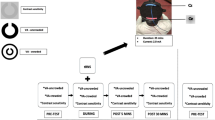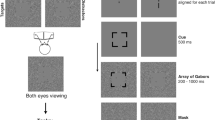Abstract
Amblyopia is a neurodevelopmental disorder of vision caused by abnormal visual experience during early childhood that is often considered to be untreatable in adulthood. Recently, it has been shown that a novel dichoptic videogame-based treatment for amblyopia can improve visual function in adult patients, at least in part, by reducing inhibition of inputs from the amblyopic eye to the visual cortex. Non-invasive anodal transcranial direct current stimulation has been shown to reduce the activity of inhibitory cortical interneurons when applied to the primary motor or visual cortex. In this double-blind, sham-controlled cross-over study we tested the hypothesis that anodal transcranial direct current stimulation of the visual cortex would enhance the therapeutic effects of dichoptic videogame-based treatment. A homogeneous group of 16 young adults (mean age 22.1 ± 1.1 years) with amblyopia were studied to compare the effect of dichoptic treatment alone and dichoptic treatment combined with visual cortex direct current stimulation on measures of binocular (stereopsis) and monocular (visual acuity) visual function. The combined treatment led to greater improvements in stereoacuity than dichoptic treatment alone, indicating that direct current stimulation of the visual cortex boosts the efficacy of dichoptic videogame-based treatment. This intervention warrants further evaluation as a novel therapeutic approach for adults with amblyopia.



Similar content being viewed by others
References
Vinding T, Gregersen E, Jensen A, Rindziunski E. Prevalence of amblyopia in old people without previous screening and treatment. Acta Ophthalmol (Copenh) 1991;69:796–798.
Holmes JM, Clarke MP. Amblyopia. Lancet 2006;367:1343–1351.
Sengpiel F, Jirmann KU, Vorobyov V, Eysel UT. Strabismic suppression is mediated by inhibitory interactions in the primary visual cortex. Cereb Cortex 2006;16:1750–1758.
Pediatric Eye Disease Investigator Group. A randomized trial of atropine vs. patching for treatment of moderate amblyopia in children. Arch Ophthalmol 2002;120:268–278.
Pediatric Eye Disease Investigator Group. A randomized trial of atropine regimens for treatment of moderate amblyopia in children. Ophthalmology 2004;111:2076–2085.
Pediatric Eye Disease Investigator Group. A randomized trial of patching regimens for treatment of moderate amblyopia in children. Arch Ophthalmol 2003;121:603–611.
Pediatric Eye Disease Investigator Group. A randomized trial of prescribed patching regimens for treatment of severe amblyopia in children. Ophthalmology 2003;110:2075–2087.
Pediatric Eye Disease Investigator Group. A randomized trial of atropine vs patching for treatment of moderate amblyopia: follow-up at age 10 years. Arch Ophthalmol 2008;126:1039–1044.
Wallace DK, Lazar EL, Melia M, et al. Stereoacuity in children with anisometropic amblyopia. JAAPOS 2011;15:455–461.
Bhola R, Keech RV, Kutschke P, Pfeifer W, Scott WE. Recurrence of amblyopia after occlusion therapy. Ophthalmology 2006;113:2097–2100.
Hess RF, Mansouri B, Thompson B. Restoration of binocular vision in amblyopia. Strabismus 2011;19:110–118.
Birch EE. Amblyopia and binocular vision. Prog Retin Eye Res 2013;33:67–84.
Narasimhan S, Harrison ER, Giaschi DE. Quantitative measurement of interocular suppression in children with amblyopia. Vision Res 2012;66:1–10.
Epelbaum M, Milleret C, Buisseret P, Dufier JL. The sensitive period for strabismic amblyopia in humans. Ophthalmology 1993;100:323–327.
Maya-Vetencourt JF, Baroncelli L, Viegi A, et al. IGF-1 restores visual cortex plasticity in adult life by reducing local GABA levels. Neural Plas 2012;250421.
He HY, Hodos W, Quinlan EM. Visual deprivation reactivates rapid ocular dominance plasticity in adult visual cortex. J Neurosci 2006;26: 2951–2955.
Harauzov A, Spolidoro M, DiCristo G, et al. Reducing intracortical inhibition in the adult visual cortex promotes ocular dominance plasticity. J Neurosci 2010;30:361–371.
Sale A, Maya Vetencourt JF, Medini P, et al. Environmental enrichment in adulthood promotes amblyopia recovery through a reduction of intracortical inhibition. Nat Neurosci 2007;10:679–681.
Sale A, Berardi N, Spolidoro M, Baroncelli L, Maffei L. GABAergic inhibition in visual cortical plasticity. Front Cell Neurosci 2010;4:10.
Hess RF, Thompson B, Black JM, et al. An iPod treatment of amblyopia: An updated binocular approach. Optometry 2012;83:87–94.
Black JM, Hess RF, Cooperstock JR, To L, Thompson B. The measurement and treatment of suppression in amblyopia. J Vis Exp 2012;70:e3927.
Knox PJ, Simmers AJ, Gray LS, Cleary M. An exploratory study: prolonged periods of binocular stimulation can provide an effective treatment for childhood amblyopia. Invest Ophthalmol Vis Sci 2012;53:817–824.
To L, Thompson B, Blum J, Hess R, Maehara G, Cooperstock J. A game platform for treatment of amblyopia. IEEE Trans Neural Syst Rehabil Eng 2011;PP:1–1.
Hess RF, Mansouri B, Thompson B. A new binocular approach to the treatment of amblyopia in adults well beyond the critical period of visual development. Restor Neurol Neurosci 2010;28:793–802.
Thompson B, Mansouri B, Koski L, Hess RF. Brain plasticity in the adult: modulation of function in amblyopia with rTMS. Curr Biol 2008;18:1067–1071.
Spiegel DP, Byblow WD, Hess RF, Thompson B. Anodal transcranial direct current stimulation transiently improves contrast sensitivity and normalises visual cortex activation in individuals with amblyopia. Neurorehab Neural Repair 2013 Jun 17 [Epub ahead of print].
Hess RF, Mansouri B, Thompson B. A binocular approach to treating amblyopia: antisuppression therapy. Optom Vis Sci 2010;87:697–704.
Spiegel DP, Hansen BC, Byblow WD, Thompson B. Anodal transcranial direct current stimulation reduces psychophysically measured surround suppression in the human visual cortex. PLoS One 2012;7:e36220.
Stagg CJ, Bachtiar V, Johansen-Berg H. The role of GABA in human motor learning. Curr Biol 2011;21:480–484.
Stagg CJ, Best JG, Stephenson MC, et al. Polarity-sensitive modulation of cortical neurotransmitters by transcranial stimulation. J Neurosci 2009;29:5202–5206.
Thompson B, Mansouri B, Koski L, Hess RF. From motor cortex to visual cortex: the application of noninvasive brain stimulation to amblyopia. Dev Psychobiol 2010;54: 263–273.
Clavagnier S, Thompson B, Hess RF. Long lasting effects of daily theta burst rTMS sessions in the human amblyopic cortex. Brain Stimul 2013 Apr 28 [Epub ahead of print].
Benninger DH, Lomarev M, Lopez G, Pal N, Luckenbaugh DA, Hallett M. Transcranial direct current stimulation for the treatment of focal hand dystonia. Mov Disord 2011;26:1698–1702.
Purpura DP, McMurtry JG. Intracellular activities and evoked potential changes during polarization of motor cortex. J Neurophysiol 1965;28:166–185.
Liebetanz D, Nitsche MA, Tergau F, Paulus W. Pharmacological approach to the mechanisms of transcranial DC stimulation induced after effects of human motor cortex excitability. Brain 2002;125:2238–2247.
Plow EB, Obretenova SN, Fregni F, Pascual-Leone A, Merabet LB. Comparison of visual field training for hemianopia with active versus sham transcranial direct cortical stimulation. Neurorehab Neural Repair 2012;26:616–626.
Plow EB, Obretenova SN, Jackson ML, Merabet LB. Temporal profile of functional visual rehabilitative outcomes modulated by transcranial direct current stimulation. Neuromodulation 2012;15:367–373.
Butler AJ, Shuster M, O'Hara E, Hurley K, Middlebrooks D, Guilkey K. A meta-analysis of the efficacy of anodal transcranial direct current stimulation for upper limb motor recovery in stroke survivors. J Hand Ther 2013;26:162–170.
Boggio PS, Nunes A, Rigonatti SP, Nitsche MA, Pascual-Leone A, Fregni F. Repeated sessions of noninvasive brain DC stimulation is associated with motor function improvement in stroke patients. Restor Neurol Neurosci 2007;25:123–129.
Black JM, Thompson B, Maehara G, Hess RF. A compact clinical instrument for quantifying suppression. Optom Vis Sci 2011;88:334–343.
Mansouri B, Thompson B, Hess RF. Measurement of suprathreshold binocular interactions in amblyopia. Vision Res 2008;48:2775–2784.
Li J, Hess RF, Chan LYL, et al. How best to assess suppression in patients with high anisometropia. Optom Vis Sci 2013;90:e47-e52.
Nitsche MA, Liebetanz D, Lang N, Antal A, Tergau F, Paulus W. Safety criteria for transcranial direct current stimulation (tDCS) in humans. Clin Neurophysiol 2003;114:2220–2222.
Nitsche MA, Doemkes S, Karakose T, et al. Shaping the effects of transcranial direct current stimulation of the human motor cortex. J Neurophysiol 2007;97:3109–3117.
Antal A, Kincses TZ, Nitsche MA, Bartfai O, Paulus W. Excitability changes induced in the human primary visual cortex by transcranial direct current stimulation: direct electrophysiological evidence. Invest Ophthalmol Vis Sci 2004;45:702–707.
Antal A, Kincses TZ, Nitsche MA, Paulus W. Manipulation of phosphene thresholds by transcranial direct current stimulation in man. Exp Brain Res 2003;150: 375–378.
Antal A, Nitsche MA, Paulus W. External modulation of visual perception in humans. Neuroreport 2001;12:3553–3555.
Antal A, Kincses TZ, Nitsche MA, Paulus W. Modulation of moving phosphene thresholds by transcranial direct current stimulation of V1 in human. Neuropsychologia 2003;41:1802–1807.
Antal A, Nitsche MA, Paulus W. Transcranial direct current stimulation and the visual cortex. Brain Res Bull 2006;68:459–463.
Antal A, Paulus W. Transcranial direct current stimulation and visual perception. Perception 2008;37:367–374.
Chatrian GE, Lettich E, Nelson PL. Ten percent electrode system for topographic studies of spontaneous and evoked EEG activities. Am J EEG Technol 1985;25:83–92.
Li J, Thompson B, Deng D, Chan LY, Yu M, Hess RF. Dichoptic training enebles the adult amblyopic brain to learn. Curr Biol 2013;23:R308-309.
Li RW, Klein SA, Levi DM. Prolonged perceptual learning of positional acuity in adult amblyopia: perceptual template retuning dynamics. J Neurosci 2008;28:14223–14229.
Li RW, Provost A, Levi DM. Extended perceptual learning results in substantial recovery of positional acuity and visual acuity in juvenile amblyopia. Invest Ophthalmol Vis Sci 2007;48:5046–5051.
Polat U, Ma-Naim T, Belkin M, Sagi D. Improving vision in adult amblyopia by perceptual learning. Proc Natl Acad Sci USA 2004;101:6692–6697.
Baker DH, Meese TS, Mansouri B, Hess RF. Binocular summation of contrast remains intact in strabismic amblyopia. Invest Ophthalmol Vis Sci 2007;48:5332–5338.
Mower GD, Christen WG. Evidence for an enhanced role of GABA inhibition in visual cortical ocular dominance of cats reared with abnormal monocular experience. Brain Res Dev Brain Res 1989;45:211–218.
Bi H, Zhang B, Tao X, Harwerth RS, Smith EL, Chino YM. Neuronal responses in visual area V2 (V2) of macaque monkeys with strabismic amblyopia. Cereb Cortex 2011;21:2033–2045.
Li J, Thompson B, Lam CS, et al. The role of suppression in amblyopia. Invest Ophthalmol Vis Sci 2011;52:4169–4176.
Li RW, Ngo C, Nguyen J, Levi DM. Video-game play induces plasticity in the visual system of adults with amblyopia. PLoS Biology 2011;9: e1001135.
Pediatric Eye Disease Investigator Group. Randomized trial of treatment of amblyopia in children aged 7 to 17 years. Arch Ophthalmol 2005;123:437–447.
Baroncelli L, Braschi C, Spolidoro M, Begenisic T, Maffei L, Sale A. Brain plasticity and disease: a matter of inhibition. Neural Plas 2011;286073.
Scali M, Baroncelli L, Cenni MC, Sale A, Maffei L. A rich environmental experience reactivates visual cortex plasticity in aged rats. Exp Gerontol 2012;47:337–341.
Sabel BA, Fedorov AB, Naue N, Borrmann A, Herrmann C, Gall C. Non-invasive alternating current stimulation improves vision in optic neuropathy. Restor Neurol Neurosci 2011;29:493–505.
Acknowledgments
This work was supported by a Faculty of Science Research Development Fund and Early Career Research Excellence Award, University of Auckland; an Auckland Medical Research Foundation Project Grant; and a Health Research Council Grant to BT; a National Natural Science Foundation of China Grant (81200715); a Thrasher Research Fund for Early Career Award to JL; and a Canadian Institutes of Health Research Grant (53346) to RFH. We thank Dr Long To and Dr Jeremy Cooperstock for their collaboration, and Dr Avinesh Pillai for valuable assistance with the statistical analysis.
Required Author Forms
Disclosure forms provided by the authors are available with the online version of this article.
Author information
Authors and Affiliations
Corresponding authors
Additional information
Daniel P. Spiegel and Jinrong Li contributed equally to this work.
Rights and permissions
About this article
Cite this article
Spiegel, D.P., Li, J., Hess, R.F. et al. Transcranial Direct Current Stimulation Enhances Recovery of Stereopsis in Adults With Amblyopia. Neurotherapeutics 10, 831–839 (2013). https://doi.org/10.1007/s13311-013-0200-y
Published:
Issue Date:
DOI: https://doi.org/10.1007/s13311-013-0200-y




